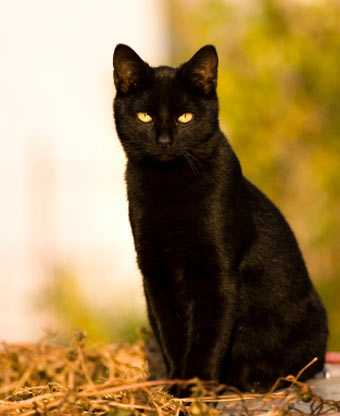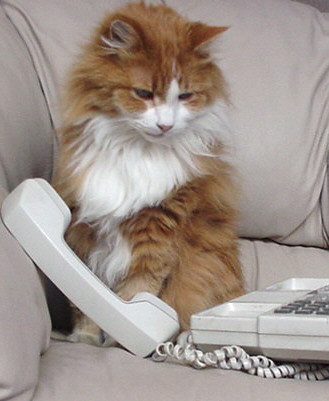Black Cat Superstitions
As superstitions go, fear of a black cat crossing one's path is of relatively recent origin. It is also entirely antithetical to the revered place held by the cat when it was first domesticated in Egypt around 3000 BC.
A black cat crossing one's path by moonlight means death in an epidemic. ~Irish superstition
All cats, including black ones, were held in high esteem among the ancient Egyptians and protected by law from injury and death. So strong was cat idolatry that a pet's death was mourned by the entire family; and both rich and poor embalmed the bodies of their cats in exquisite fashion, wrapping them in fine linen and placing them in mummy cases made of precious materials such as bronze and even wood - a scarcity in timber-poor Egypt. Entire cat cemeteries have been unearthed by archaeologists, with mummified black cats commonplace.
Dread of cats, especially black cats, first arose in Europe in the Middle Ages, particularly in England. The cat's characteristic independence, willfulness, and stealth, coupled with its sudden overpopulation in major cities, contributed to its fall from grace. Alley cats were often fed by poor, lonely old ladies, and when witch hysteria struck Europe, and many of these homeless women were accused of practicing black magic, their cat companions (especially black ones) were deemed guilty of witchery by association.
One popular tale from British feline lore illustrates the thinking of the day. In Lincolnshire in the 1560s, a father and his son were frightened one moonless night when a small creature darted across their path into a crawl space. Hurling stones into the opening, they saw an injured black cat scurry out and limp into the adjacent home of a woman suspected by the town of being a witch. Next day, the father and son encountered the woman on the street. Her face was bruised, her arm bandaged. And she now walked with a limp. From that day on in Lincolnshire, all black cats were suspected of being witches in night disguise. The lore persisted. The notion of witches transforming themselves into black cats in order to prowl streets unobserved became a central belief in America during the Salem witch hunts. Thus, an animal once looked on with approbation became a creature dreaded and despised.
Many societies in the late Middle Ages attempted to drive cats into extinction. As the witch scare mounted to paranoia, many innocent women and their harmless pets were burned at the stake. A baby born with eyes too bright, a face too canny, a personality too precocious, was sacrificed for fear that it was host to a spirit that would in time become a witch by day, a black cat by night. In France, thousands of cats were burned monthly until King Louis XIII, in the 1630s, halted the shameful practice. Given the number of centuries in which black cats were slaughtered throughout Europe, it is surprising that the gene for the colour black was not deleted from the species... unless the cat does possess nine lives.
Many people believe that a black cat brings good fortune and also, that anyone who finds the one perfect, pure white hair in an all-black cat and plucks it out without being scratched, will find great wealth and good luck in love.
In Britain, on the Yorkshire coast, wives of fishermen believe that their menfolk will return safely if a black cat is kept in the house.
A black cat in the audience on opening night portends a successful play.
In the south of France, black cats are referred to as "matagots" or "magician cats." According to local superstition, they bring good luck to owners who feed them well and treat them with the respect they deserve.
Black cats were once treated like royalty in the homes of English sailors, who believed that keeping them happy would ensure fair weather when they went to sea. They became so high-priced that few sailors could afford them!
"Whenever the cat of the house is black,
The lasses of lovers will have no lack." ~ English Proverb
Black cats aren't bad luck everywhere. In the English Midlands, a black cat as a wedding present is thought to bring good luck to the bride.
General Cat Superstitions
A cat is very often kept as a lucky mascot in the theatre and disaster strikes any actor who dares to kick it!
In Normandy, seeing a tortoiseshell cat foretells death by accident.
English schoolchildren believe seeing a white cat on the way to school is sure to bring trouble. To avert bad luck, they must either spit, or turn around completely and make the sign of the cross.
A cat sneezing is a good omen for everyone who hears it. ~Italian superstition
If a cat washes behind its ears, rain is coming. ~English superstition
A cat sleeping with all four paws tucked under means old weather ahead. ~English superstition
It is bad luck to cross a stream carrying a cat. ~French superstition
Never kick a cat or you will get rheumatism; never drown one or the devil will get you. Throughout the world it is considered to be bad luck to mistreat a cat. This worldwide respect for the cat is probably rooted in those ancient religions in which the cat was a sacred animal and where retribution would befall those who harmed it.
In Scotland in 1590, the witch John Fian and other members of his coven, were charged with having raised or attempted to raise a storm, so as to drown King James VI of Scotland (and the First of England) then returning from Denmark. Fian and his accomplices used cats, by flinging them into the sea, to effect their devilish purpose.
In what was known as Bohemia, in western Czechoslovakia, the cat is regarded as a symbol of fertility and one buried in a field of grain will guarantee a good harvest.
The Japanese prefer their own native short-tailed cat - the Japanese Bobtail - because they are less likely to bewitch humans. Japanese sailors have long taken tricoloured or me'kay cats on their ships to bring them good luck. The figure of a cat with its left paw raised is commonly seen in gift shops in that country, where they are sold as souvenirs. It is believed that the beckoning cat brings good fortune to its owner.
Sailors believe that if a ship's cat mews and appears to be cross, they will face a hard voyage - but if it is bright and lively, there will be a brisk "following" wind. It used to be said that a contrary wind at sea could be raised by shutting a cat in a canister. Throwing a cat overboard resulted in an immediate storm. No sailor would dream of doing this, however, since it was considered good luck to have a cat on board.
It is said that in the southern regions of France, if a young unmarried girl accidentally steps on a cat's tail, she will have to wait twelve months before she finds a husband.
A celtic belief was that kittens born in May were badly behaved and troublesome. In Celtic mythology, the month of May was a time of ill-omen.
Occult powers are often attributed to cats. It is said that they also have the power of hypnotism. A cat with three different hues in its coat protect one against fire and fever.
An American hill country superstition says that a cat can decide whether or not a girl should get married. The debating bride-to-be takes three hairs from the cat's tail and wraps them in paper, which she then places under her door step. If in the morning, the cat hairs are arranged in a Y pattern, the answer is Yes,but if the hairs form the letter N, the answer is no.
It is said that to dream of cats is unfavourable as this denotes treachery. In Tasseography - fortune-telling by tea leaves - a cat signifies false friends and deceit; someone lies in treacherous ambush, probably a false friend.
If the household cat sneezes near the bride on her wedding morning, the marriage will be a happy one.
When a cat washes its face in the parlour, company can be expected.
It is said that a cat looking out of the window is looking for rain.
In America, black and white and also grey cats are considered to be lucky.
It is unlikely to hear a cat crying before setting off on a journey. If this happens, return and find out what it wants.
No cat which has been bought will ever be any good at catching mice.
Indonesians and Malays believe that if you wash your cat it will bring rain.
In Western Europe it is widely believed that if a cat washes over its ears, it is a sign of rain.
When cats rush about wildly, clawing at curtains and cushions, it means that wind is coming.
When cats sit with their back to the fire, look out for frost or a storm.
There you have it!
Irene Carson is the administrator for the Elvira Mistress of The Dark Horror Forum and horror movies message board located at http://mistressofthedarkhorrorforums.aimoo.com Discussion includes splatter horror, classic horror films, upcoming horror movies and the latest in horror news. You may repost this article as long as all links and original content are included.
Grab The Bookmarketer For Your Site

